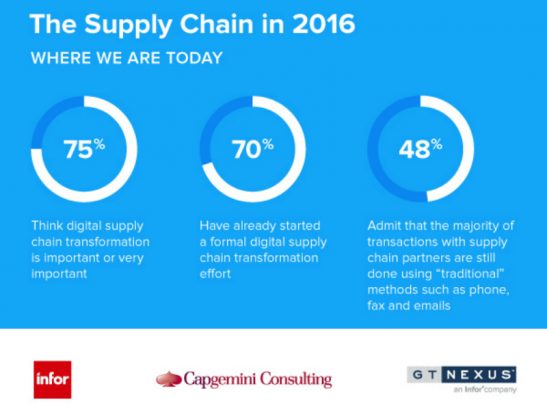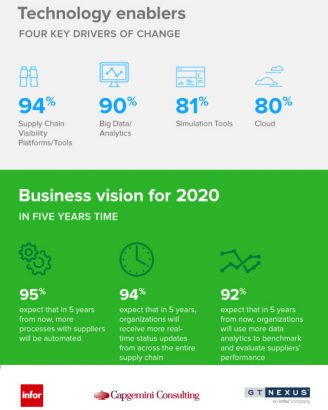
The types of Digital Transformation
Digital Transformation is one of the biggest buzz phrases around. A lot of research has already been done on this topic, though it typically examines Digital Transformation within organisations, or between businesses and their customers.
But in today’s globalized and outsourced world, success is no longer dependent on a single business’ efforts. Today, success depends largely on how effectively a business can orchestrate a vast, global network of supply chain partners to deliver goods and services that meet the needs of individual consumers. Success is inherently collaborative.
This means that in order to undergo a successful Digital Transformation, a business is now largely dependent on the transformation of every partner along its value chain and all the processes and information flows between those different partners. Digital Transformation must also become inherently collaborative. Successful transformation needs to adopt a holistic view of the entire ecosystem of partners, from raw material providers, manufacturing partners and suppliers, logistics and transportation providers to retail and distribution channels.
What happens between the individual parties on the network is just as, if not more important than what happens within each one. And what should happen between the parties is data sharing and collaboration.
Overcoming traditional communication to collaborate
Recent research from GT Nexus, an Infor company, and Capgemini Consulting has found that there is still a huge amount to do to achieve this. In a recent survey of supply chain decision makers across Europe and North America, 48% of respondents admitted that “traditional” methods such as phone, fax, email are still the dominant ways to interact with supply chain partners. These restrict collaboration and often limit what can be achieved in any digital transformation project.

The same research found that these executives expect dramatic changes within just five years. Only 15% of respondents say that the majority of data from the extended supply chain is accessible to their organisation today. In five years they expect this to reach 54%. Only 23% of respondents say that the majority of data from the extended supply chain is analysed and used for decision-making. In five years, that number jumps to 68%.
Perhaps most tellingly, in 5 years from now, 95% of respondents expect more processes with suppliers to be automated and 94% expect to receive more real-time status updates from across the entire supply chain.
From here to there – the obstacles ahead
Closing this large gap between where organisations see themselves on their joint Digital Transformation journey with their value chain partners today, and where they want to be in five years from now, is going to be very challenging.
Achieving this level of collaboration is not going to be easy. Transforming a large global organisation by itself is difficult enough. Including an entire ecosystem of hundreds of external partners in the process within just five years will be impossible without vision, leadership, investments in the right technologies and superior execution. More importantly, failure to transform is not an option.
It is worth noting that these demands are both real and present now – this is not some forward-looking potential consideration. 70% of respondents to the research stated that their organisations have already launched a formal Digital Supply Chain Transformation effort.
A third of respondents were dissatisfied with their progress in these projects. A general lack of awareness throughout the internal ranks of their own organisation was reported by 44% of executives. A lack of skills in the workforce is also a factor for 39% of respondents.
A similar set of obstacles appear to slow down collaboration and progress outside the four walls of the business. 50% of respondents said that their supply chain partners lacked the necessary awareness. Meanwhile the skills gap was more acute 42% saying their supply chain partners lacked the required skills.
There are also technological barriers. Cloud-based software is considered a key driver of Digital Business Transformation in general. One area where it has the potential to be major value driver is Supply Chain Management. The reason is that is enables the vital cross-company processes, collaboration and data-sharing that is required for transformation.
Despite this cloud-based software is not widely used yet. 69% of respondents admit that less than 25% of their software is cloud-based. Consequently, there is a profound reliance on “traditional” technologies like phone, fax and emails.
Modern, global supply chains can easily encompass hundreds or thousands of different trading partners across the world. A persistent reliance on outdated, manual, analogue tools of communication such as phone, fax and email is fundamentally at odds with the collaborative needs of the ever-changing, fast-moving, disruption-prone nature of today’s global supply chains.
As a result of this use of older technology, over half of respondents (52%) admit that their organisation has very little access to data from the extended supply chain (defined as less than 25% of data accessible). Five years from now, 54% of organisations expect to have access to the majority of the data from the extended supply chain.

Conclusion
It is hard to overstate the scale of change that is coming. When the executives were asked to look ahead at how key aspects of managing their ecosystem of supply chain partners will evolve within a 5-year time frame, the survey found overwhelming consensus:
- More processes with suppliers will be automated than today (95% agreement)
- Organisations will receive more real-time status updates from across the entire supply chain than today (94% agreement)
- Organisations will use more data analytics to benchmark and evaluate supplier’s performance than today (92%)
The role of technology is no longer confined to harnessing data. It’s also about better collaboration and tighter relationships with supply chain partners. In five years from now, organisations will share more data with suppliers than today. They will collaborate more closely and involve suppliers more closely in the planning process. There will be more real-time visibility into supplier processes and companies will expect suppliers to invest more money into their IT systems while holding those suppliers to higher ethical standards
Digital Transformation projects are about to re-fuel the need for greater collaboration between enterprises and their supply chain partners. These projects will mark substantial shifts in the type of technology deployed, but most of all Digital Transformation will mean that businesses will have to continually be mindful of what goes on outside of their four walls just as much as what happens within them.
This means that businesses must now look throughout their supply chains and networks to identify the areas of weakness of their ongoing digital transformation strategies. The communication across these networks will need world class platforms and those businesses already maximising the use of supply partners face a pressing need to ensure they are using the best forms of technology available.
























